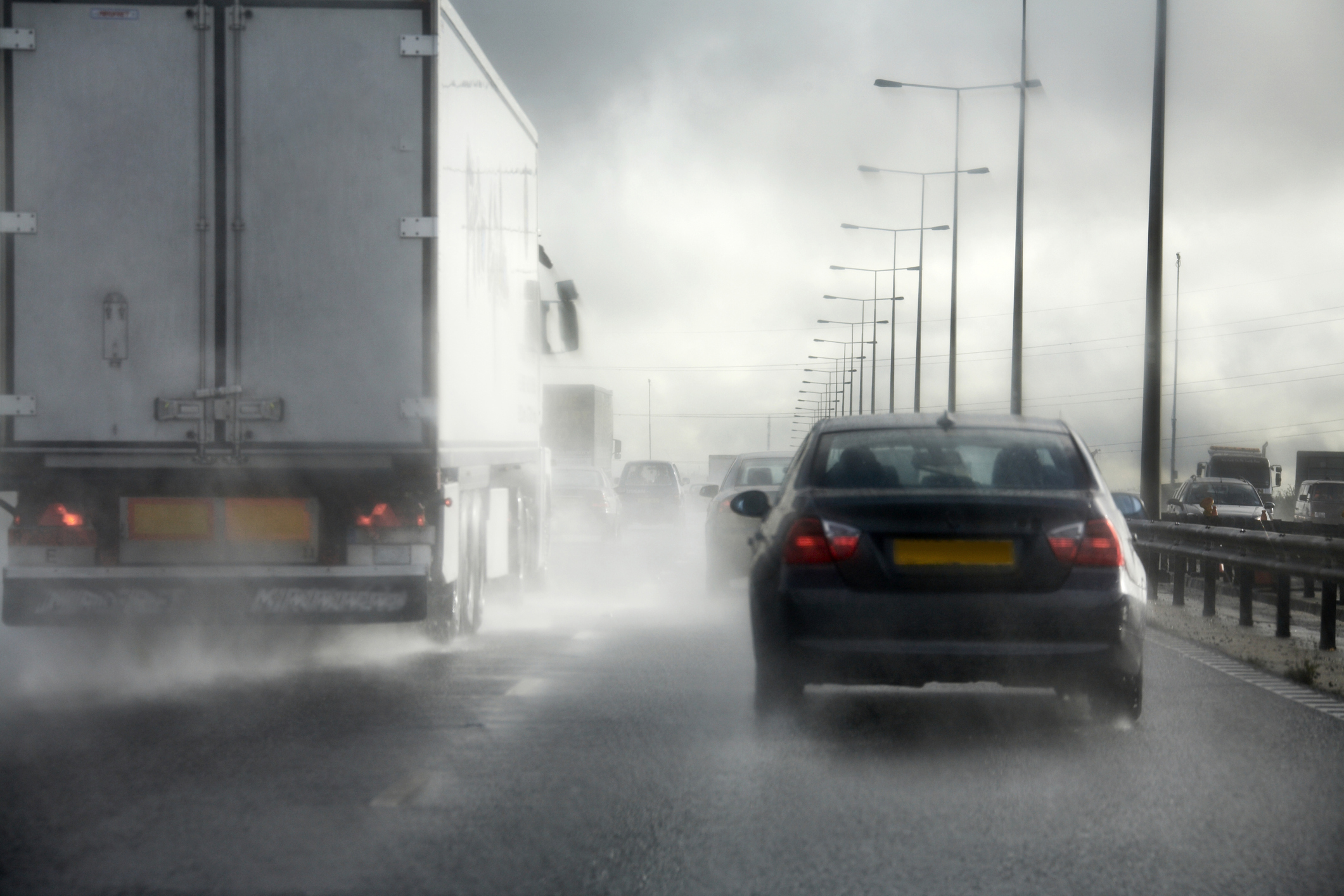Eight reasons you could get fined up to £5,000 while driving in Storm Jocelyn
Motorists face fines of up to £5,000 plus penalty points for flouting rules during bad weather. We outline common driving mistakes, whether you’ve got an electric vehicle or a diesel or petrol car.


Following Storm Isha, Storm Jocelyn is now upon us resulting in the Met Office issuing more severe weather warnings for strong winds and flooding.
Jocelyn is the 10th named storm to hit the UK since September.
You may not fancy going out in this weather, but many people will need to drive their cars for work or the school run, or to go shopping.
MoneyWeek
Subscribe to MoneyWeek today and get your first six magazine issues absolutely FREE

Sign up to Money Morning
Don't miss the latest investment and personal finances news, market analysis, plus money-saving tips with our free twice-daily newsletter
Don't miss the latest investment and personal finances news, market analysis, plus money-saving tips with our free twice-daily newsletter
Motorists must consider the challenges that storms present to ensure they are getting behind the wheel safely, as well as avoiding hefty fines and penalty points.
Drivers could be at risk of being fined up to £5,000 as well as receiving penalty points on their driving licence for a host of reasons.
These include not being visible on the roads, wearing the wrong clothing, failing to clear snow and ice off sensors, having damaged windscreen wipers, and even comforting a frightened pet in the car.
Whether you drive an electric vehicle (EV) or a petrol or diesel car, we run through eight driving rules to keep in mind as storm Jocelyn grips the countr
1, Driving without your headlights on (up to £1,000 fine)
Make sure you’re using your headlights correctly or risk being fined up to £1,000.
In stormy conditions when visibility is reduced, motorists should be using dipped headlights.
According to rule 226 of the Highway Code, “you MUST use headlights when visibility is seriously reduced, generally when you cannot see for more than 100 metres (328 feet). You may also use front or rear fog lights but you MUST switch them off when visibility improves.”
Although all modern cars made after 2011 are fitted with automatic “daytime running lights” (DRLs) for visibility, it is important to remember that you should switch on brighter lights when necessary.
You could be slapped with a £50 on-the-spot fine if stopped by the police for failing to have the correct lights on.
However, the RAC warns that charges can increase to £1,000 for not being visible when driving along the roads during poor weather. In extreme circumstances, it could even result in a 12-month driving ban.
2, Driving with only one headlight working (£100 fine)
While it’s a good idea to check your automatic headlights are on, motorists also need to check that no bulbs need replacing.
Tim Rodie, resident driving expert at car retailer Motorpoint, tells MoneyWeek: “Driving with only one working headlight not only reduces your visibility but will also make it harder for other motorists to see you. Not to mention, if you’re pulled over by the police with only one headlight, you can expect a £100 fine and three points on your licence.”
He adds: “The quickest way to check is to walk around your car with the headlights on to make sure all the bulbs are working as they should. While you’re at it, make sure your indicators are working – just switch your hazards on and look for any lights that don’t blink properly.”
3, Driving before properly demisting your windows or clearing snow (£1,000 fine)
The stormy conditions can make your morning commute challenging. However, no matter how late you’re running, you should always take time to ensure you have full visibility of the road.
Failing to have proper control of the vehicle or a full view of the road and traffic ahead can result in a penalty of £1,000. You could also gain three penalty points.
Before setting off, make sure your windows are clear of ice, while also removing any snow that could fall and obstruct the path of other drivers. Check your lights and number plates are visible before climbing in and thoroughly de-misting your car’s interior.
Maria McCarthy, author of Driving Test Secrets You Need to Know, advises: “When it comes to de-icing, you'll need to make sure all the windows are completely clear – don't just scrape a letterbox or porthole-sized space and assume you can just peer through that while the rest of the ice melts. Clear all-round vision is essential."
4, Neglecting to clear your car’s sensors of mud and snow (£100 fine)
Drivers should also check their sensors are working correctly before setting off in stormy conditions.
Thom Groot, chief executive of The Electric Car Scheme, a salary sacrifice employee benefit scheme, comments: “Most modern vehicles rely on sensors to understand their surroundings, navigate environments and adapt to various conditions. The camera sensors interpret the objects in the road around the car but poor weather conditions, like rain and snow, can limit their visibility.
“If a vehicle’s sensors begin to fail or are damaged and you’re unable to comply with traffic signs you could end up with a £100 fine and three penalty points. Just as you would wipe your number plate clear of any debris, be sure to wipe your car’s sensors of any snow, mud, or other obstructions.”
5, Leaving charge point cables untidy while charging an EV (£130 fine)
Storms can create all sorts of hazards for pedestrians, like slippery leaves on the pavements, icy pathways, and even reduced visibility.
So, it’s important to make sure you don’t add to the hazards by leaving electric vehicle charging cables lying around for someone to trip over.
Groot notes: “Leaving your vehicle in a dangerous position could land you with three penalty points and a fine of up to £130. The cost of the fine will depend on the seriousness of the offence and the council area.”
According to The Electric Car Scheme, penalty charge notices (PCNs) issued outside of London range from £50 to £80, while fines issued inside the capital cost £130 or £80. You could also be subjected to a £50 non-endorsable fixed penalty notice (FPN) for the negligent use of a motor vehicle.
Groot adds: “The Highway Code rule 239 states that you should park close to the charge point and avoid creating a trip hazard for pedestrians from trailing cables. After using the charge point, you should return the charging cables and connectors neatly to minimise the danger to pedestrians.”
6, Driving with damaged windscreen wipers (£2,500 fine)
The Department for Transport states that all windscreen wipers “must be properly adjusted and maintained in efficient working order” and that failure to do so could lead to dangerous driving scenarios.
According to the RAC, this could lead to a £2,500 fine and three penalty points.
If you’re found to commit the offence (or one similar) twice within a three-year span from the original offence, then you could be disqualified from driving for a minimum of six months.
7, Driving while wearing winter gloves, woolly scarf or chunky boots (£1,000 fine)
Whether it’s a fashion choice or you’re simply trying to stay warm, it’s important to keep your full attention on the road while driving.
Scarves, gloves and heavy coats could not only limit your mobility but also create unnecessary distractions.
“Failing to have proper control of the vehicle or full view of the road and traffic ahead can result in a penalty of £1,000 or three penalty points,” says Groot. “So, where possible, opt for cracking up your car’s heating to make the vehicle warm then wrap up in winter wear when you’re at your destination.”
Maria McCarthy adds that it's important to wear the right footwear for driving “or you could be fined”. She explains: “Avoid wearing high heels or any chunky boots that reduce the amount of control you have when operating the pedals.”
8, Comforting your pet while driving (up to £5,000 fine)
Extreme weather can be stressful for animals but motorists risk big fines for trying to comfort their pets while driving.
Tim Rodie comments: “While it’s quite common to see pets riding in the owners' laps or with their head out of the window, this is directly at odds with what is outlined in the Highway Code. According to Rule 57, when in a vehicle dogs or other animals must be suitably restrained so they cannot distract you while you are driving or injure you, or themselves if you need to stop quickly.”
He explains that just because there isn’t a direct penalty for driving with an unrestrained animal in the vehicle, it doesn’t mean there isn’t a risk of being fined.
“If you were to be distracted by your pet while behind the wheel, you could find yourself charged with driving without due care and attention.
“This comes with a fine of £1,000 and penalty points, but if the case were to go to court this could increase to up to £5,000 and nine points on your licence.”
Get the latest financial news, insights and expert analysis from our award-winning MoneyWeek team, to help you understand what really matters when it comes to your finances.

Ruth is an award-winning financial journalist with more than 15 years' experience of working on national newspapers, websites and specialist magazines.
She is passionate about helping people feel more confident about their finances. She was previously editor of Times Money Mentor, and prior to that was deputy Money editor at The Sunday Times.
A multi-award winning journalist, Ruth started her career on a pensions magazine at the FT Group, and has also worked at Money Observer and Money Advice Service.
Outside of work, she is a mum to two young children, while also serving as a magistrate and an NHS volunteer.
-
 Why you fear money – and how to fix it: MoneyWeek Talks
Why you fear money – and how to fix it: MoneyWeek TalksPodcast MoneyWeek's digital editor, Kalpana Fitzpatrick, speaks to financial psychotherapist Vicky Reynal about how to change your money mindset for the better.
-
 How cancelling unused direct debits could boost your pension by £37,000
How cancelling unused direct debits could boost your pension by £37,000A new year refresh of your spending could save you money and help boost your pension pot.